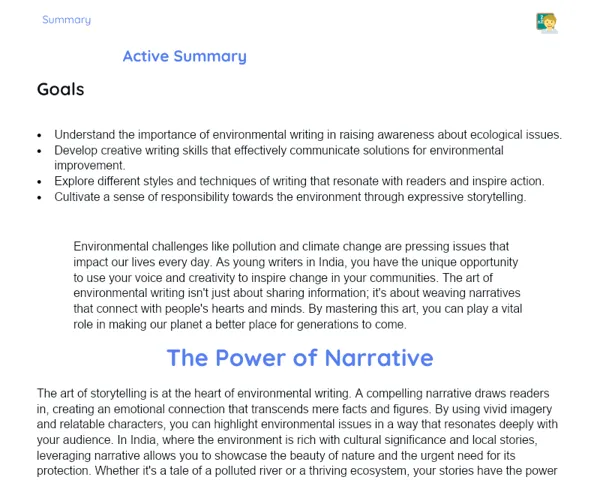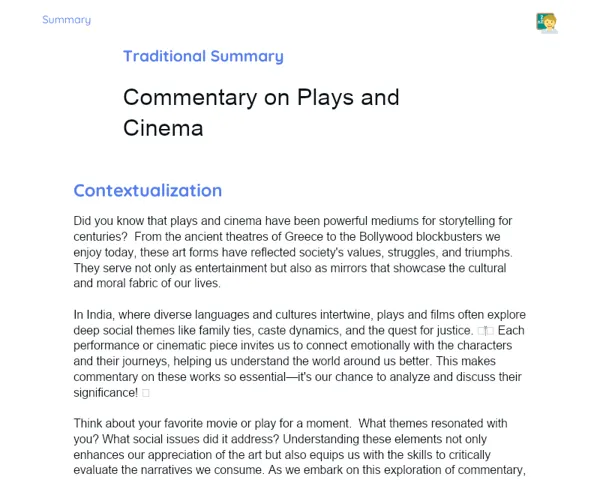## Goals
1. Understand how to blend personal experiences with imagination to create engaging stories or poems.
2. Identify different narrative techniques and styles that enhance creative writing.
3. Develop skills to express emotions and ideas effectively through written words.
Contextualization
Did you know that storytelling has been an integral part of Indian culture for centuries? From the rich tales of the Ramayana and Mahabharata to the vibrant folktales of regional communities, weaving personal experiences into stories has always captured hearts and minds. In fact, many of the legendary tales we hear today originated from the everyday lives of people, transformed into powerful narratives that inspire generations! Writing stories inspired by our experiences is not just a skill; it’s a way to carry forward traditions and share our unique viewpoints with others.
Subject Relevance
To Remember!
Blending Personal Experiences
Blending personal experiences into your writing is like mixing spices into a pot of curry—it adds depth and flavour! Personal experiences serve as a treasure trove of genuine emotions and real-life scenarios that can help readers relate to your story. By infusing your own memories, feelings, and observations, you not only create authenticity but also encourage readers to connect their experiences with yours. Imagine writing about that time you helped your friend during a tough moment—this personal touch can evoke empathy and resonate deeply with your audience.
-
Genuine Connection: Using personal experiences makes your writing relatable, drawing readers into the world you've created.
-
Emotional Depth: Real-life experiences can evoke emotions, making your stories impactful and meaningful.
-
Cultural Reflection: By sharing your unique experiences, you contribute to cultural narratives that can inspire others.
Imaginary Elements
While personal experiences form the backbone of your stories, letting your imagination run wild is what adds the magical flair! Imaginary elements allow you to stretch the boundaries of reality. For instance, if you write about a visit to a mysterious jungle, you can invent talking animals or hidden treasures. This blend of the real and the fantastical creates a dynamic narrative that captivates readers and transports them into an intriguing world. Think of your imagination as the paintbrush that colours the canvas of your story!
-
Creativity Boost: Imagination expands your narrative possibilities, allowing for adventurous and unpredictable plots.
-
Engagement Factor: Readers love surprises! Adding fantastical elements keeps them on the edge of their seats.
-
Personal Exploration: Imagination lets you express aspects of yourself through characters and scenarios, further enriching your narrative.
Narrative Techniques
Narrative techniques are the tools you use to craft your story; they are like the instruments in an orchestra that come together to create a beautiful melody. Techniques such as dialogue, foreshadowing, and flashbacks can add layers and dimensions to your writing. For example, using dialogue brings characters to life, allowing readers to hear their voices and personalities. Understanding these techniques enhances your storytelling abilities, making your writing more dynamic and engaging. It’s about telling your story in the most captivating way possible!
-
Character Development: Effective use of dialogue and action helps build well-rounded characters that readers can connect with.
-
Plot Construction: Techniques like foreshadowing can create suspense, keeping readers eagerly turning the pages.
-
Pacing and Flow: Narrative techniques help control the speed at which your story unfolds, balancing excitement and reflection.
Practical Applications
-
Start a personal journal to document daily experiences and reflect on feelings that could inspire stories later.
-
Participate in storytelling sessions with friends or family, using imaginative elements to narrate real or fictional events.
-
Engage in creative writing exercises where you mix one personal experience with a fantastical twist, such as turning a family trip into an adventure involving friendly dragons.
Key Terms
-
Narrative: A spoken or written account of connected events; a story.
-
Dialogue: The written conversational exchange between characters in a story.
-
Foreshadowing: A literary device used to give an indication or hint of what is to come later in the story.
-
Flashback: A scene set in a time earlier than the main story, used to provide background or context.
Questions for Reflections
-
Think about a moment in your life that changed your perspective. How would that experience shape the story you want to tell?
-
Imagine your life as a grand adventure. What characters would play a significant role, and what plot twists would you include?
-
How can blending your own experiences with elements of imagination help convey messages in your stories? Reflect on a recent story you read and its deeper meaning.
The Magical Adventure Challenge
Transform a real-life experience into a fantastical adventure! Take a memory from your life and reimagine it with imaginative elements, like magical creatures or unexpected twists.
Instructions
-
Choose a personal experience that stands out for you.
-
Think of how you can add imaginative elements to it—maybe a talking animal or a secret door to another world.
-
Write a short story (about one page) that narrates this transformed adventure.
-
Illustrate your story with drawings or doodles that complement the plot!



